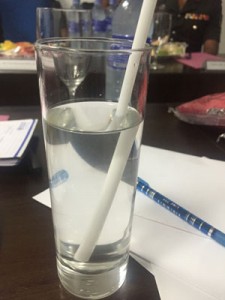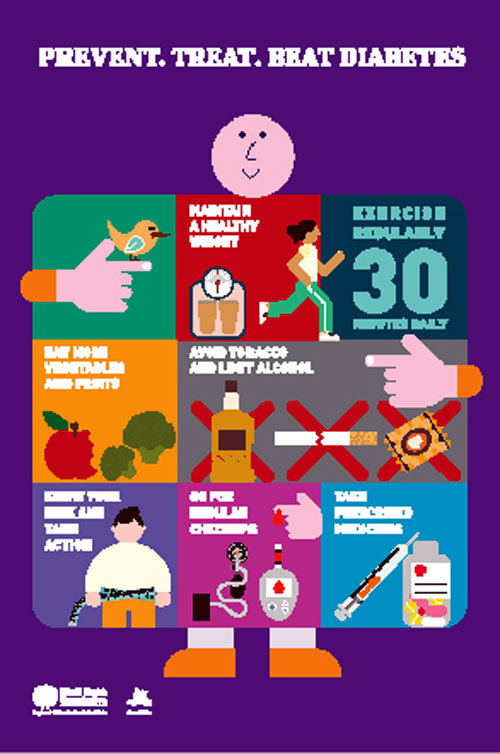News
Alarming rise in diabetes: Act right now to prevent, treat and beat it

WHO Representative: Dr. Jacob Kumaresan
Talking the talk and walking the walk, is what the Colombo Office of the World Health Organisation (WHO) is engaging in, to meet head-on the looming spectre of non-communicable diseases (NCDs).
With this year’s World Health Day campaign targeting diabetes, the eminent invitees to the function on April 7 at the Kingsbury Hotel were presented with a strange little pack – a measuring tape and a skipping rope.
These two simple items included a health ‘yardstick’ and if the indicator was not satisfactory, a corrective tool.
The measuring tape would indicate whether the waist circumference was healthily right — for women less than 32” and for men less than 36”. If not, the skipping rope would be an incentive for the receivers to skip their way to a weight-reduction. Even if the waist circumference was ideal, these tokens would encourage them to continue their exercise regimen.
The passion with which the crucial need to Prevent, Treat and Beat Diabetes is spoken of by WHO’s Sri Lanka Representative Dr. Jacob Kumaresan infuses interest in anyone around him.
Quoting the “alarming” figures put forward by the first-ever WHO Global Report on Diabetes, he says:
n Since 1980, the number of diabetics in the world has jumped, in fact quadrupled, from 108 million to 422 million in 2014. Diabetes causes around 1.5 million deaths a year.
n If we don’t do anything and let the current trends continue, the numbers would double in the next 20 years to 850 million in 2035.

The health-aids presented to invitees: A measuring tape and a skipping rope
“The burden is huge and the reason is our lifestyle, what we eat and what we do,” says Dr. Kumaresan, reiterating that what we need is healthy eating and exercise.
Before we talk of the unknown or un-thought of reality of how many calories we consume — with each teaspoonful of sugar we add to our steaming cups of tea gulped down throughout the day or that tempting slice of pizza we bite into — Dr. Kumaresan brings the microscope down on Sri Lanka.
n 1 in 4 is not exercising
n 1 in 10 is a diabetic when taking the whole country
n In urban areas such as the Western Province 1 in 4 is a diabetic
Sounding an urgent warning, he is quick to point out that there is a huge group which is still undetected.
Picking up the three points of the World Health Day theme – Prevent, Treat, Beat Diabetes, in reverse, the WHO Representative recalls treating a patient who was in his late 40s in India a long time ago.
“He didn’t know he was a diabetic. A wound on his leg developed gangrene and an amputation below the knee was necessitated. It was very sad, as he, the breadwinner, had to go back in a wheelchair and was dependent on his family even though his employer provided compensation. A while later, he came in for diabetic retinopathy and lost his eyesight,” says Dr. Kumaresan, pointing out that this man was “finished” at 50.
Severe social issues followed, as he could not fend for his family and the family had to sell its assets one-by-one, which dragged not only the patient but his whole family into impoverishment. This is why we need to ‘beat’ diabetes, he stresses.
 What’s on the menu? Healthy foodThe meeting was at the Army Hospital in Colombo and the WHO Representative was pleasantly surprised. What’s on the menu? Healthy foodThe meeting was at the Army Hospital in Colombo and the WHO Representative was pleasantly surprised. What was served was a plate of fruit and a glass of thambili (king coconut) to everyone present. This is what the Army Hospital has been doing for a while – serving healthy food and drink at all meetings held there. The good practices are coming in, says Dr. Kumaresan, adding that the Health Ministry will soon be serving tea and sugar separately, giving a choice to a person at a meeting to either have his/her cuppa without sugar or with less sugar. The UN is also planning to follow suit. Lauding the booklet ‘Eats @ Meets’ which the Health Ministry, the College of Community Physicians of Sri Lanka and the Sri Lanka Medical Nutrition Association launched on World Health Day, he says that it contains a guide to menu planning at worksite meetings. Wide-ranging, the booklet covers menus for breakfast, lunch and dinner; beverage, dessert and snack and snack-salad options; and tips for snacks at different times of the day. |
Contrasting this patient’s plight with his own sister who was diagnosed with diabetes at 30, Dr. Kumaresan explains how a routine test zeroed-in on the fact that she was a diabetic. She was put on insulin and took her medications diligently. Around that time she had a baby boy who is now 25 years old. She is 60+ now and leading a productive life, without any diabetes-related complications such as peripheral neuropathy, kidney issues or eyesight problems.

The plate of fruit and glass of thambili served at Army Hospital meetings
“This is why early diagnosis is vital as well as diligent treatment and patient compliance,” he says, dealing with the ‘treat’ of the theme.
Of course, prevention or delaying the onset of diabetes is of paramount importance, according to Dr. Kumaresan, who says what is essential is the adoption of the ‘Life Course Approach’.
This does not begin in adulthood but from the time a baby is in the womb with the mother eating the right food and when the baby is born breastfeeding the baby. When the time is right to wean the baby, it should be on healthy food and as he/she grows older, within the home they should be given healthy drinks and food.
“All this must be seen by parents as their duty,” he says, pointing out that the school environment, too, should be geared for exercise programmes and healthy food options in the canteens. If, however, there is no healthy choice they will go down the pathway of unhealthy eating. When children who have been nurtured on healthy food and drink enter university as young adults, they will be equipped with knowledge to make the right choices.
Practising what the WHO preaches, meanwhile, there has been preliminary screening of the 180 staff of the United Nations agencies in Colombo and startling have been the findings.
Among the staff 19%, were either known or unknown diabetics, says Dr. Kumaresan, citing the case of a young male who thought he was healthy but had a blood sugar level way above the normal. Now all the staff members have been gifted with pedometers to keep count whether they walk the required 10,000 steps (5km) a day to keep healthy and reduce their weight. This is why regular screening is important with follow-up if medication is needed.
“We need a paradigm shift if we are to win the war against NCDs including diabetes and it has to happen not tomorrow, in a few weeks, a few months or six months. It has to happen right now, in our homes, schools, universities, workplaces, nationally and globally,” adds Dr. Kumaresan.
| War against diabetes, other NCDsPointing out the responsibility of different groups in the war not only against diabetes but also other NCDs, Dr. Kumaresan says: - The government needs to do its part by bringing in legislation to ensure healthy food options for people, with all food and drink products indicating clearly the nutrient-content as well as the calorie-count. There should also be parks where people can walk and exercise. Healthy food and drink should also be affordable. - Australia and India are planning to tax sugary drinks under the ‘sin-tax’ so that this revenue can be used for health promotional activities like in the case of taxes on tobacco and alcohol. Higher the sugar content, higher the taxes should be. Although manufacturers fighting back will be a huge challenge, this is needed to create healthy populations and ultimately manufacturers will fall in line. - Hotels, restaurants and bakeries should indicate the calorie-count against each item of food and drink on their menus. . With numerous meetings and extra snacking being the order of the day for top executives, not only the corporate sector but also the state sector should look at healthy options. - Schools, universities and workplaces should have healthy menus and wherever possible gyms. Employees should be given time, may be on a staggered basis to use the gym along with facilities such as good showers, with small incentives to motivate staff to lose weight. Long term, the employers would benefit as there would be less absenteeism due to illness and they would have a healthier and more productive workforce. The Sports Ministry has shown the way by opening a gym for its staff. |
| Here is some food for serious thought from Dr. Kumaresan:- The calorie-requirement of an average person is around 2,000 calories per day, usually calculated on a person’s Body Mass Index (BMI). - Breakfast should be the biggest meal each day as a person can burn up the calories during the day. Next would be a reasonable lunch, with dinner being the smallest meal, either soup or fruit. “Asians have a big problem, because we snack during the day on fried stuff along with sugary drinks,” says Dr. Kumaresan, adding that we also have a late and heavy dinner and go straight to bed. - Just 100 calories per day in excess of the calorie-requirement of a person would pile on 5 kilos per year to that person’s weight. - o burn off the calorie-intake from a slice of pizza, a person would have to do a 45-minute brisk walk. - A teaspoonful of sugar amounts to 15 calories, and if a person has six cups of tea with just one teaspoonful of sugar that would add on 90 calories per day. - A piece of cake has about 250 calories. · Short-eats such as fried cutlets etc would have between 150-200 calories per item.
|
| Food for thought Here is some food for serious thought from Dr. Kumaresan: - The calorie-requirement of an average person is around 2,000 calories per day, usually calculated on a person’s Body Mass Index (BMI). - Breakfast should be the biggest meal each day as a person can burn up the calories during the day. Next would be a reasonable lunch, with dinner being the smallest meal, either soup or fruit. “Asians have a big problem, because we snack during the day on fried stuff along with sugary drinks,” says Dr. Kumaresan, adding that we also have a late and heavy dinner and go straight to bed. - Just 100 calories per day in excess of the calorie-requirement of a person would pile on 5 kilos per year to that person’s weight. - o burn off the calorie-intake from a slice of pizza, a person would have to do a 45-minute brisk walk. - A teaspoonful of sugar amounts to 15 calories, and if a person has six cups of tea with just one teaspoonful of sugar that would add on 90 calories per day. - A piece of cake has about 250 calories. · Short-eats such as fried cutlets etc would have between 150-200 calories per item.
|


